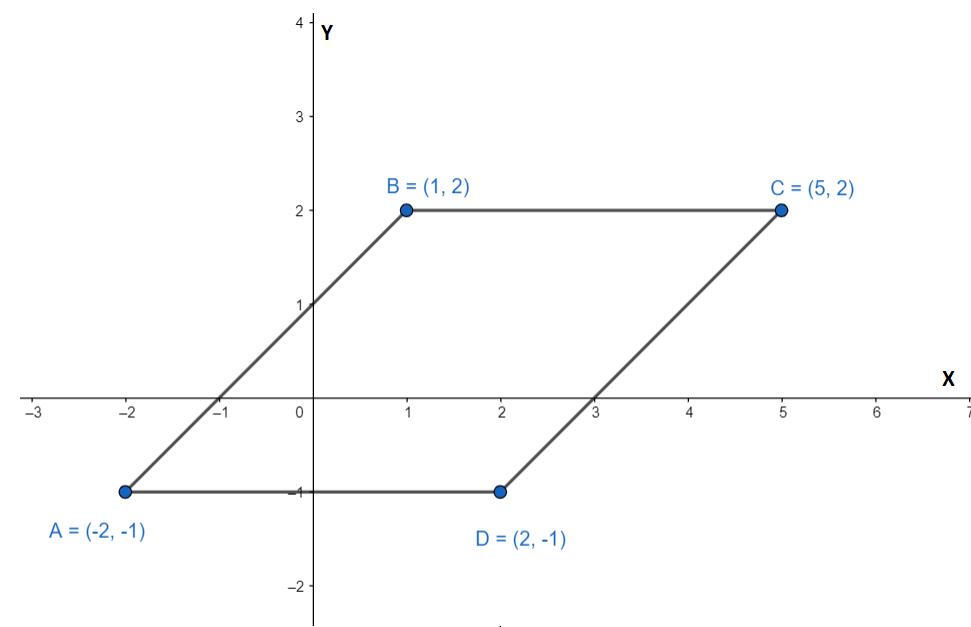
How do you prove that quadrilateral \[ABCD\] is a parallelogram \[A(-2,-1),B(1,2),C(5,2)\And D(2,-1)\] using slope?
Answer
547.2k+ views
Hint: A parallelogram is a quadrilateral in which the opposite sides are parallel and of equal length. To check whether a quadrilateral is a parallelogram or not. We have to check if its opposite sides are parallel. As we know that parallel sides have equal slopes, in other words, we have to check if the opposite sides have an equal slope or not. For any given two points, \[M(a,b)\And N(c,d)\] the slope of the line joining two points is \[\dfrac{d-b}{c-a}\].
Complete step-by-step answer:

We are given the points \[A(-2,-1),B(1,2),C(5,2)\And D(2,-1)\]. We have to prove that these points make a parallelogram. As we know that the opposite sides of a parallelogram are parallel, which means that their slope is the same. We can prove that this is a parallelogram by showing that the slope of the opposite sides is the same. We know that, for any given two points, \[M(a,b)\And N(c,d)\] the slope of the line joining two points is \[\dfrac{d-b}{c-a}\]. We can find the slope of the line joining these points as follows,
For line joining \[A(-2,-1)\And B(1,2)\], the slope of the line \[AB\]\[=\dfrac{2-(-1)}{1-(-2)}=\dfrac{2+1}{1+2}=\dfrac{3}{3}=1\]
For the line joining \[B(1,2)\And C(5,2)\], the slope of the line \[BC=\dfrac{2-2}{5-1}=0\].
For the line joining \[C(5,2)\And D(2,-1)\], the slope of the line \[CD=\dfrac{-1-2}{2-5}=\dfrac{-3}{-3}=1\].
For the line joining the \[A(-2,-1)\And D(2,-1)\], the slope of the line \[AD=\dfrac{-1-(-1)}{2-(-2)}=0\].
From the above values, we can say that \[AB\And CD\] and \[BC\And DA\] are parallel as their slopes are equal.
Hence the quadrilateral \[ABCD\] is a parallelogram.
We can also plot the points on the graph as follows,
Note: One should remember the properties of the sides, angles, diagonals of different types of quadrilaterals to solve these types of questions. Here if we calculate the length of the sides \[AB,BC,CD,\And AD\] they are \[3\sqrt{2},4,3\sqrt{2}\And 4\] respectively. Hence the opposite side length is the same, we can use this also to prove that the quadrilateral that is formed with these points is a parallelogram.
Complete step-by-step answer:

We are given the points \[A(-2,-1),B(1,2),C(5,2)\And D(2,-1)\]. We have to prove that these points make a parallelogram. As we know that the opposite sides of a parallelogram are parallel, which means that their slope is the same. We can prove that this is a parallelogram by showing that the slope of the opposite sides is the same. We know that, for any given two points, \[M(a,b)\And N(c,d)\] the slope of the line joining two points is \[\dfrac{d-b}{c-a}\]. We can find the slope of the line joining these points as follows,
For line joining \[A(-2,-1)\And B(1,2)\], the slope of the line \[AB\]\[=\dfrac{2-(-1)}{1-(-2)}=\dfrac{2+1}{1+2}=\dfrac{3}{3}=1\]
For the line joining \[B(1,2)\And C(5,2)\], the slope of the line \[BC=\dfrac{2-2}{5-1}=0\].
For the line joining \[C(5,2)\And D(2,-1)\], the slope of the line \[CD=\dfrac{-1-2}{2-5}=\dfrac{-3}{-3}=1\].
For the line joining the \[A(-2,-1)\And D(2,-1)\], the slope of the line \[AD=\dfrac{-1-(-1)}{2-(-2)}=0\].
From the above values, we can say that \[AB\And CD\] and \[BC\And DA\] are parallel as their slopes are equal.
Hence the quadrilateral \[ABCD\] is a parallelogram.
We can also plot the points on the graph as follows,
Note: One should remember the properties of the sides, angles, diagonals of different types of quadrilaterals to solve these types of questions. Here if we calculate the length of the sides \[AB,BC,CD,\And AD\] they are \[3\sqrt{2},4,3\sqrt{2}\And 4\] respectively. Hence the opposite side length is the same, we can use this also to prove that the quadrilateral that is formed with these points is a parallelogram.
Recently Updated Pages
Why are manures considered better than fertilizers class 11 biology CBSE

Find the coordinates of the midpoint of the line segment class 11 maths CBSE

Distinguish between static friction limiting friction class 11 physics CBSE

The Chairman of the constituent Assembly was A Jawaharlal class 11 social science CBSE

The first National Commission on Labour NCL submitted class 11 social science CBSE

Number of all subshell of n + l 7 is A 4 B 5 C 6 D class 11 chemistry CBSE

Trending doubts
1 Quintal is equal to a 110 kg b 10 kg c 100kg d 1000 class 11 physics CBSE

What is Environment class 11 chemistry CBSE

Bond order ofO2 O2+ O2 and O22 is in order A O2 langle class 11 chemistry CBSE

How many squares are there in a chess board A 1296 class 11 maths CBSE

Distinguish between verbal and nonverbal communica class 11 english CBSE

The equivalent weight of Mohrs salt FeSO4 NH42SO4 6H2O class 11 chemistry CBSE




